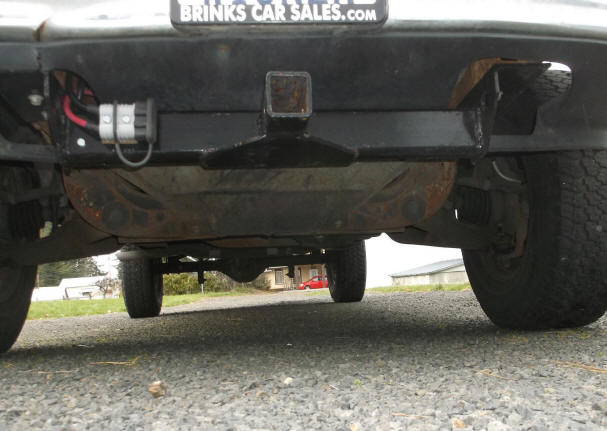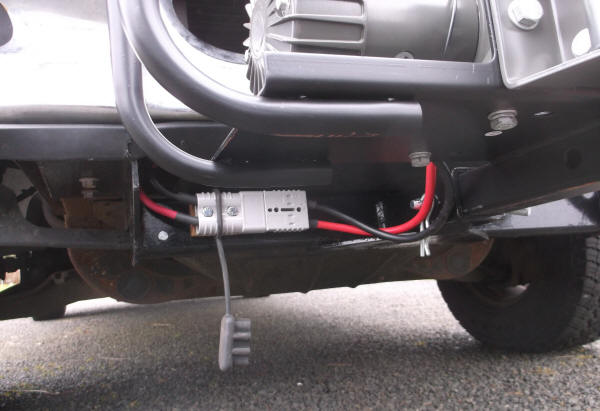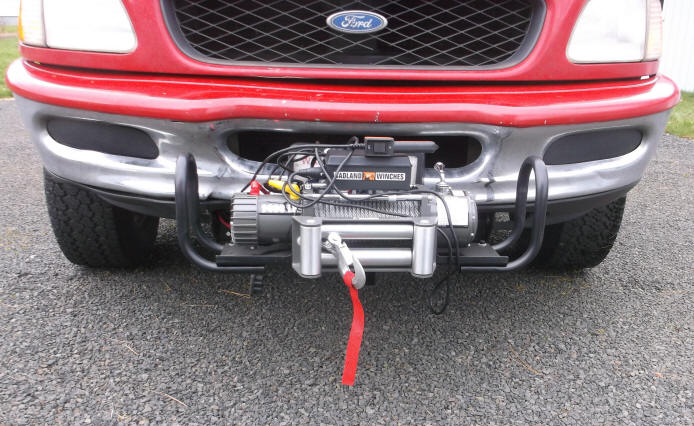 |
Adding a
Removable 12 Volt
Winch to Your Pickup |
 |
How many times have you been going to or from a hunting or fishing trip and got in a situation where you began wondering if you would even find a place to even turn your rig around? And if in deep snow, getting deeper and going uphill, you will really begin to wonder. Sure you may have even had a set of tire chains with you, but there is always the situation where you may become stuck, or may need to pull someone else out of a ditch.
In 2013, my grandson and I were hunting in Montana late in the season with a foot of snow on the ground. Driving in an unknown area, we were not sure we could find a turn around at the head of a canyon, so when the first possible place presented itself, we turned around. Another location, we stopped short because of uncertainties of getting stuck and walked in another 4 miles. As we were walking coming out, we could hear a vehicle's engine revving over a mile away and at a higher elevation than we were. It was getting late in the afternoon, I asked him if he was thinking of going to help that person. No, because he was not sure which road they may have been on AND even if we could find them, may not even be able to help or we could even get stuck ourselves. Along with no cell phone reception there, plus a 15 mile hike back to the nearest civilization. His comment was in Montana, with all the open space, you have to be self-reliant and NEVER allow yourself to get into a situation that you can not get out by yourself.
Electric winches are not that inexpensive anymore and if you mount them in a traditional manner on the front bumper/frame, unless you occasionally service them because of dust, rain and road salt corrosion, they may not even function when you need it.
Most of these winches are mounted on the front bumper or frame, but sometimes you want to go back the way you came, and not get deeper into an unknown situation. So this removable unit that can also be mounted on the rear of the vehicle appeared pretty appealing. The idea of having a removable electric winch becomes something that may solve more than one issue. Enter the idea of mounting a winch onto a trailer hitch type bracket by adding another receptacle coupler on the vehicle frame in front for the that winch location, then you can use it on your existing rear trailer hitch receptacle to pull yourself out backwards if applicable, if needed.
Finding the Right Model and Size ; Price can also be a deciding factor, especially for an old retired geezer on a limited fixed income. The size I was looking at was 5,000# to 6,000# rated. US made units are selling for from $550 to $730. Harbor Freight had a sale on Chinese manufactured units for $199, but as luck would have it, they were out of stock of that model when I got there. So for another $100, up to $299, I came home with their next higher rating unit, a 9,000# version, a little overkill, but the rational was if I ever need it, I don't want failure because of being too small, overheating and burning it up. The solenoid and remote control plug in receptacle is mounted in a plastic box that is situated above the drum and clamped onto the winch crossbars. This one has a clutch engage lever on the top of the gearbox.
Add another $45 for a trailer hitch mount with two side hand holds for transporting it to the trailer receptacle. However this one is heavy enough that one person CAN move it, but not easily, where two would be considerably easier.
This unit came with 65' of 5/16" galvanized wire cable and with a removable 12' remote control rocker switch module.
Yes I know, why buy Chinese imports? Well for one the price, for two, I will probably not use it a lot, and three, I already have it's little brother, a 2,000# one on my quad that works quite fine. In talking to a friend who is a motorcycle/ATV dealer, he related that, yes probably these are a almost direct copy of the US made models, but what they found in his business is usually the electrical solenoid or contacts usually fail first if used a lot, as compared to the US made units.
Years ago, I had a US made Warm electric winch on the front bumper of a 1968 Ford F250 4X4 pickup, so do understood a bit of how they could come in handy for numerous things from winching yourself out of a washout or an elk out of a canyon to even taking down large limbs on standing LARGE (4-5' on the stump) walnut trees that we then took the rest of the tree down that we used to make gunstocks out of. These trees were so close to buildings that there was no room to fall them, so hang a block near the top of the main tree and take them down in large pieces.
Survey the Situation ; After crawling under the front of my 1997 Ford F150 4X4 pickup many times and after much measuring, steel was purchased and a mounting frame was built to bolt onto the frame using the same bolts that had held the original tow eyes.
Build the Mounting Bracket ; The steel consisted of 1/4" X 4" X 4" angle iron to bolt to the frame. The original two tow eyes were removed, the hole pattern transferred to the angle iron and the holes drilled. Once these angles were bolted in place, then the distance between the two was measured and a 1/4" X 2 1/2" x 3 1/2" rectangle tubing was tack welded in place. Then another square section of 1/4" X 2 1/2" X 2 1/2" was purchased for the hitch receptacle. This tack welded section was then removed and moved into the shop for a better location to do the final welding instead of laying on my back. A 1/4" triangle plate was welded on the bottom, stiffening up the receptacle square tubing to the cross bar tubing.
| Here is the new cross-bar frame mounted to the vehicle frame with the permanent part of the power cable quick disconnect bolted onto it. The bolt head to the left of the disconnect has the battery ground under the nut on the rear side. |
 |
In this process, the tow eyes had to be removed, but to somewhat replace these, a 1 1/8" hole was drilled in the front vertical sides of the angle iron. Originally the thought was to replace these tow eyes with large clevises, but the size needed and the price was a deterrent, so the 1 1/8" holes were left as is for the interim, but later, large 5/8" thick steel tow eyes were welded to the outer side of the angle iron side plates.
Installation ;
Now
came the wiring. This winch unit came with #4 AWG wire for running to the
battery. And since this unit was to be used either front or rear, some
sort of electrical quick disconnect was needed. These were found at
Car-Quest in the large 175 AMP size cable connector by PICO #6383PT, that fit a
standard #4 battery cable wire. They also had a 50 AMP unit, but it only used a #10
wire and the distance from the battery to the rear trailer hitch extension was
20', which needed the heavier #4 cable (more expensive, like $2.59 a foot). No sense of wiring it wimpily
only to burn something up when you really need it because of overheating a
undersized wire.
These connectors costing $18 each are unisex, meaning no male or female,
(being identical) but are made to rotate the one 180 degrees and the two slide
and lock together under spring tension under the contact. Two sets were
needed, one on the shorter winch cables and another 1/2 on each end of the longer
battery cables, front and rear. These fittings were
all soldered to the cable for better conductivity and less problems in the long
run and sealed with heat shrink tubing. The positive lead (RED) was run from the supplied circuit breaker at
the battery, forward along the frame and out near the new cross-member and
attached to a connector that was bolted to this cross-member out of the way but
near the foreword winch mount. A short negative BLACK ground wire was ran from this
coupler to a cleaned and drilled location on this frame close to the
connector. No need to run a ground wire all the way to the battery as
the battery was already grounded to the frame, so just use the frame as a
runner. The same was done for the rear coupler, with the red #4 wire being
tie taped in numerous places to the frame.
A rubber cover is made to fit these couplers to keep the connectors
clean and only cost $3.50 each.
| Shown below is the power cable quick disconnect system with wires going to the battery & to the winch, with the protective cover just hanging in this instance |
 |
This unit comes with a 12' remote rocker switch that automatically goes back to neutral when you take your thumb off the button as seen in the photo below laying on top of the winch. This uses a indexed plug in on the side of the plastic solenoid box that mounts on top of the winch. With this remote, it is long enough to be used from inside the vehicle if I happen to be stuck and alone, or outside if being used to pull someone else out.
| Here the finished product is mounted on the front of the pickup |
 |
And I still have two sections of 1/4" aircraft cable that totals about 900' that I kept when I sold the 68 Ford, which could be carried along "just in case". And I just built a 4" dia. snatch block
Another reason for making this fit the front frame mount is that if and or when I may have 8' cabover camper in the pickup bed, there is not any room if I want to take my 1850 Watt Coleman generator along. This front mount trailer hitch unit will also be the temporary home for this generator if and when I will be away from 110 Volt electrical power.
Copyright © 2014 - 2020 LeeRoy Wisner All Rights Reserved
Back to the Main Ramblings
Page
Originated 02-15-2014, Last updated
11-09-2020
Contact the author